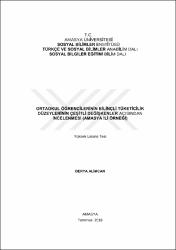| dc.contributor.advisor | Şam, Emine Altunay | |
| dc.contributor.author | Alimcan, Derya | |
| dc.date.accessioned | 2022-03-09T14:56:08Z | |
| dc.date.available | 2022-03-09T14:56:08Z | |
| dc.date.issued | 2018 | |
| dc.identifier.uri | https://tez.yok.gov.tr/UlusalTezMerkezi/TezGoster?key=fS4sqEZr79C_n60Rk6MjFTMXMBBzubWx9pfjU1X1g-GpiyMn89bsmuK8Ld7EXzPV | |
| dc.identifier.uri | https://hdl.handle.net/20.500.12450/1836 | |
| dc.description.abstract | Bu tezde ortaokul öğrencilerinin bilinçli tüketicilik düzeyleri çeşitli değişkenler açısından incelenmiştir. Çalışmada, nicel araştırma yöntemlerinden ilişkisel tarama modeli kullanılmıştır. Çalışma verileri 2015-2016 eğitim-öğretim yılının bahar döneminde toplanmıştır. Halil İbrahim Sağlam tarafından (2010) geliştirilen Bilinçli Tüketicilik Düzeyi Ölçeği (BTDÖ), Amasya il merkezinde bulunan 3 ortaokulun 5., 6. ve 7. sınıflarında okumakta olan 885 öğrenciye uygulanmıştır. Verilerin analizi SPSS 20 programında yapılmıştır. Normal dağılım gösteren değişkenlerde parametrik testler (t testi, Anova), normal dağılım göstermeyen değişkenlerde nonparametrik testler (Mann-Whitney U, Kruskal Wallis) uygulanmıştır. Gruplar arasında görülen farklar yorumlanırken "Post Hoc Testi"nden yararlanılmıştır. İki değişken arasındaki ilişki araştırılırken, normal dağılım göstermediği için "Spearman's-rho" katsayıları yorumlanmıştır. Araştırma sonucunda bilinçli tüketicilik puanlarının okullara göre farklılaştığı, cinsiyete göre farklılık görülmediği, anne öğrenim durumu ilkokul ve altı olan öğrencilerin "Bütçe-Fiyat Bilincinin" yüksek olduğu, baba öğrenim durumu yüksek olanların "Kalite Bilinci" puanlarının yüksek çıktığı, sınıf düzeyi arttıkça bilinçli tüketicilik düzeylerinin düştüğü görülmüştür. Bunun yanı sıra televizyon izleme süresi, bilgisayar kullanma süresi, satın alma eğilimi ile bilinçli tüketicilik puanları arasında düşük de olsa negatif yönde bir ilişki görülmüştür. Ayrıca eğitici programlar, haber ve belgesel programları izleyen öğrencilerin bilinçli tüketicilik puanları yüksek çıkarken magazin, gerilim ve şiddet içerikli programları izleyen öğrencilerin bilinçli tüketicilik puanları düşük çıkmıştır. | en_US |
| dc.description.abstract | In this thesis, conscious consumerism levels of secondary school students were studied in terms of different variables. Correlational research model, one of the quantitative research methods, was used in this work. Data of this work was collected in Spring term of 2015-2016 education year. Developed by Halil İbrahim Sağlam (2010), Measurement of Conscious Consumerism Level was applied to 885 students studying at 5th, 6th and 7th grades in 3 secondary schools in Amasya city center. Data analysis was carried out on SPSS 20 program. Parametric tests (T Test, Anova) were used for the variables showing normal distribution, non-parametric tests (Mann-Whitney U, Kruskal Wallis) were used for variables not showing normal distribution. ''Post Hoc Test'' was used to interpret the differences between the groups. Researching the correlation between two variables, ''Spearman's-rho'' coefficients were interpreted as it didn't show normal distribution. It can be inferred from the results of the research that conscious consumerism points differ according to schools, that there is not a difference according to gender, that the students whose mothers with primary school education or below have high level of ''budget-price consciousness,'' that the students whose fathers with high level of education have high ''quality consciousness''points and that the higher grade of the students, the lower level of conscious consumerism. Besides, it was seen that there was a small correlation in negative way between conscious consumerism points and duration of watching TV, using computer, tendency to buy. Also, while conscious consumerism points of the students watching news and documentaries are high, points of students watching magazine programs and programs with violence content are low. | en_US |
| dc.language.iso | tur | en_US |
| dc.publisher | Amasya Üniversitesi | en_US |
| dc.rights | info:eu-repo/semantics/openAccess | en_US |
| dc.subject | Eğitim ve Öğretim | en_US |
| dc.subject | Education and Training | en_US |
| dc.subject | Amasya | en_US |
| dc.subject | Amasya | en_US |
| dc.subject | Bilinçli tüketim | en_US |
| dc.subject | Conscious consumption | en_US |
| dc.subject | Ortaokul öğrencileri | en_US |
| dc.subject | Secondary school students | en_US |
| dc.subject | Tüketicilik | en_US |
| dc.subject | Consumerism | en_US |
| dc.subject | Tüketim | en_US |
| dc.subject | Consumption Onaylandı | en_US |
| dc.title | Ortaokul öğrencilerinin bilinçli tüketicilik düzeylerinin çeşitli değişkenler açısından incelenmesi (Amasya ili örneği) | en_US |
| dc.title.alternative | Investigation of conscious consumerism levels of middle school students in terms of various variables (Amasya city sample) | en_US |
| dc.type | masterThesis | en_US |
| dc.department | Enstitüler, Sosyal Bilimler Enstitüsü, Türkçe ve Sosyal Bilimler Eğitimi Ana Bilim Dalı | en_US |
| dc.identifier.startpage | 1 | en_US |
| dc.identifier.endpage | 94 | en_US |
| dc.identifier.yoktezid | 528814 | en_US |
| dc.institutionauthor | Alimcan, Derya | |


















